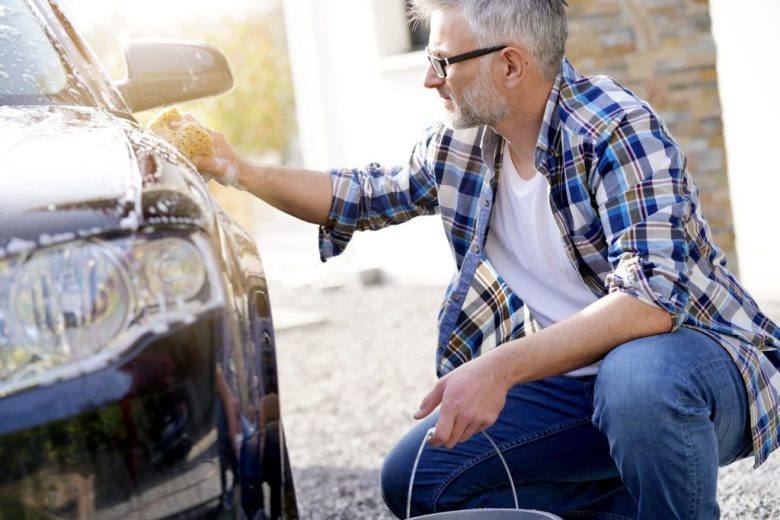Your car is an investment and a valuable asset therefore, using the proper techniques, propriety tools, and methods is key for effective and efficient washing. Failure to implement wash properly will stain and scratch the exterior of your vehicle.
Eliminate as much grime as possible using a soft cloth or sponge when you rinse your vehicle and ensure that you are utilizing two separate buckets: a soapy water bucket and one for rinsing your cleaning cloth or sponge.
1. Overuse of Soap
Excessive use of cleaning products can severely ruin the exterior of the car by damaging the paint, alongside making it more difficult to rinse and wash away. To prevent such actions, ensure that you read the instructions that come with the cleaning products. Use approximately 20 parts water and one part soap as this will be able to create an optimal lather alongside helping protect the paint of the vehicle.
By using too much soap, soap scum is created and will mix with the dirt and dust particles present inside the car. This will make the cabin of the vehicle smell bad while also agitating the eyes. The optimum dosages of soap is available on the manufacturers website.
The most glaring issue when cleaning a vehicle in direct sunlight is dashing to wipe off the water or soap. This leads to streaking and spotting on the paint job. To improve these results, wash in the shade.
As part of their washing process, most people drop their towels while doing so. This is a bad mistake as it brings in dirt particles which get into your paint and scratch it further. To minimize this possibility and ensure efficient measuring results, graduated buckets that have markings at every gallon line would help enormously. Finally, during this process, many people from time to time pollute the wash water when they drop their dirty wash towels during this step.
2. Putting too much water
Having a large amount of water during car washing is both a waste of water and very damaging to the vehicle; putting swirl marks and water spots that dull it and scratch it further. There are a number of changes you can make to your washing routine in order to reduce the use of water such as lowering presoak times, less towels, or including a solution with filtered or deionized water.
A waste water reclamation system is one way that you can lower water consumption in a car wash. This system reuses water that has been previously used during washing cycles, which minimizes the amount of soap, wax, and drying chemicals used. This also reduces the direct release of waste water into the local waterways and prevents contamination of local water sources.
Waste water reclamation comes with costs too. Employees using care washes need to be thoroughly trained with the soaps and chemicals used to wash each vehicle, as there are many safety risks that can occur. Ignoring product instructions can inflict harm toward other workers, including breakdowns of machinery and oil spills. A good way to minimize these include proper training of the equipment, deployment of protective clothing and gloves to handle the equipment, and making sure that hoses and equipment cannot get stuck in the conveyor belts. Preventing these scenarios will protect workers from being harmed by the machinery and ensure that the equipment operates seamlessly.
3. Excessive Use of Towels
A car wash setup requires a myriad of supplies and equipment; failing to meet basic construction practices could result in severe financial losses.
In considering cleaning automobiles, the utilization of towels and sponges that are either unclean or not intended for the specific task on hand is one of the most profound mistakes. Such towels and sponges are likely to muddy the different parts of the car, which can lead to scratches and smudges and furthermore, dull the vehicle and cause it to rust quicker than anticipated.
When you do the cleaning yourself, it is important to understand that when cleaning the vehicle at home, a separate bucket that is designated for soapy water and another rinse water needs to be utilized. If a single dirty bucket is used, all the filth that you made such effort to scrub off will undoubtedly be placed right back on the vehicle!
Rinse out of direct sunlight and use mild car soap; soapy water should be rinsed out of direct sunlight in order to prevent it from drying fast which leads to undesirable mineral marks being left behind on the vehicle.
After rinsing the car, patch for spots and streaks with the advanced BLISS’ full-service car wash where physical drying and air drying is used in combination with the tunnels serving the purpose.
4. Leaving Water Marks
Water marks have the ability to both severely damage the aesthetics and reduce the resale value of a car. Water marks occur from mineral residue being left on the paint surface for an extended period. Once created, the remnants are stubborn and can lead to etching if not managed correctly. Proper car washing techniques, such as sealing post washing with wax or sealant, can be used to lower mark formation and maintain resale value.
Washing in direct sunlight is one of the main causes of car water marks. The heat increases the rate at which soap and water evaporates which results in unfavorable marks being left on the paint surface. To resolve this issue, shading, such as early morning washing or the use of a smartwash tunnel, can be implemented.
Another issue which can result in water spots is using products not intended for automotive purposes. While some say they can eliminate spots and streaks, most of them have dangerous chemicals that may damage the paint surface. To eliminate water spots entirely, use automotive pH-balanced car shampoo and ensure the vehicle is rinsed thoroughly from top to bottom after every wash cycle.




